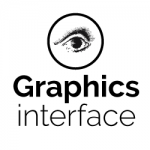A 2023 CHCCS/SCDHM Achievement Award from the Canadian Human-Computer Communications Society is presented to Academy Award winning Professor Demetri Terzopoulos for his pioneering and sustained contributions to computer graphics over the course of nearly four decades. He has shown remarkable prescience, envisioning long before others several of the most important research directions in the field. His more than 400 scholarly publications in multiple scientific domains include ground-breaking papers that have given impetus to the physics, biology, learning, and artificial life (Alife)-based approaches to computer graphics modeling and animation.
His seminal SIGGRAPH ‘87 paper on “Elastically Deformable Models” established Terzopoulos as the founder of physically-based modeling and animation. In its 2005 Academy Award for Technical Achievement to him and John Platt for their “pioneering work in physically-based computer-generated techniques used to simulate realistic cloth in motion pictures,” the AMPAS formally recognized their paper as “a milestone in computer graphics, introducing the concept of physically-based techniques to simulate moving, deforming objects.” His subsequent papers on Deformable Models (a term Terzopoulos coined that now appears in the IEEE Taxonomy) included a SIGGRAPH ‘88 paper with Kurt Fleischer that first introduced inelastic deformation and fracture mechanics to computer animation. Terzopoulos’s pioneering work has inspired a vibrant worldwide industry of research, with publications on deformable models appearing unabated in every major conference on computer graphics, and in other fields such as computer vision and medical imaging, since 1987.
Terzopoulos next broadened the scope of his graphics research to include biologically-based modeling and animation, an area in which he is now also widely recognized as a pioneer and leading proponent. His early work, with Keith Waters, yielded the first realistic, muscle-actuated biomechanical model of the human face, published in 1990, prompting much follow-on work globally on physically-based facial animation, including their highly-cited SIGGRAPH ‘95 paper on “Realistic Modeling for Facial Animation” with Terzopoulos’s student Yuencheng Lee.
Terzopoulos’s research subsequently expanded greatly to encompass ALife modeling, demonstrating the tremendous scope and power of a paradigm that subsumes all aspects of living systems, from biomechanics to intelligence. Not only has he been the leading champion of this richly multidisciplinary approach, but his foundational work has been field-defining. A landmark SIGGRAPH ‘94 paper with his student Xiaoyuan Tu introduced the influential ALife model known as “Artificial Fishes”, for which Tu’s University of Toronto PhD dissertation won the 1996 ACM Doctoral Dissertation Award, the first time that this coveted prize recognized a non-US dissertation. This was followed by the ground-breaking SIGGRAPH ‘99 paper on “Cognitive Modeling” with John Funge and Tu, which revealed the potential of cognitive AI for autonomous character animation. Since 2000, with successive PhD students (Shao, Yu, Huang), he published influential papers on “Autonomous Pedestrians”, propounding an ALife-based multi-human simulation approach acutely differentiated from mainstream crowd simulation.
Terzopoulos moreover pioneered the harnessing of machine learning for computer graphics. A SIGGRAPH ‘95 paper with his student Radek Grzeszczuk on “Learning Muscle-Actuated Locomotion” opened the way with reinforcement learning, and their SIGGRAPH ‘98 paper on “The NeuroAnimator” with Geoffrey Hinton, marked the first use of neural networks in computer graphics, specifically demonstrating the promise of data-driven learning to efficiently emulate realistic physical dynamics and effectively control physics-based animation. This latter work was well ahead of its time, but deep learning has recently become a hot topic permeating the graphics field.
Since 2004, Terzopoulos and a succession of his students (Lee, Si, Nakada, Lakshmipathy, Zhou) have been engaged in the most ambitious and comprehensive work on biomimetic human simulation in any field. His UCLA group has pioneered the combination of biomechanical and sensorial modeling as well as the most advanced application of deep learning in computer graphics to date, specifically achieving automated neuro-musculoskeletal and neuro-sensorimotor control in their unprecedentedly anatomically-detailed biomechanical model of the human body (SIGGRAPH ‘06, TOG ‘09, TOG ‘14, SIGGRAPH ‘18, SIGGRAPH-Asia ‘19).
Terzopoulos has been a professor of computer science, electrical and computer engineering, and mathematics who has taught undergraduate and graduate level computer graphics at three universities (Toronto, NYU, UCLA). In a Web3D ‘19 paper “An Online Collaborative Ecosystem for Educational Computer Graphics” he and his student Garret Ridge describe their innovative pedagogical software infrastructure, which has benefitted many students at UCLA, where Terzopoulos is currently a Distinguished Professor and Chancellor’s Professor of Computer Science. He is a former Guggenheim Fellow, Canada Council for the Arts Killam Research Fellow, NSERC EWR Steacie Memorial Fellow, CIFAR AI and Robotics Fellow, and a Fellow of the ACM, IEEE, Royal Society of London, Royal Society of Canada, and other scholarly societies. He has received many major awards, among them IEEE’s Computer Pioneer Award, Helmholtz Prize, and inaugural Computer Vision Distinguished Researcher Award. He has given more than 500 invited talks worldwide about his research, among them over 150 distinguished/plenary/keynote addresses. Terzopoulos graduated in Honours Electrical Engineering from McGill University and obtained his doctorate in Artificial Intelligence from MIT.





